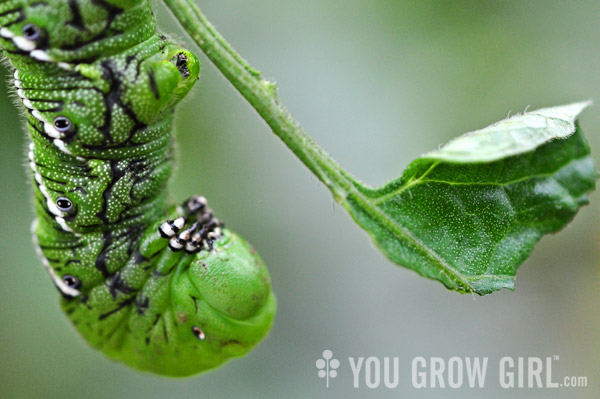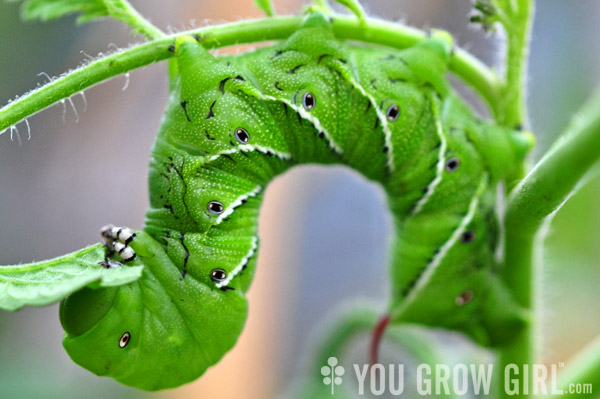
First things first: I don’t have tomato hornworms (Manduca quinquemaculata) in my own garden. What you see above is a photo that I took a few weekends ago of a Tobacco Hornworm (Manduca sexta) fatting itself up on my tomatoes. The caterpillars of these two distinct species of moth look very much alike and are easily confused. For reference, the tomato hornworm has v-shaped markings down its sides and a dark black/brown “horn” protruding out the back, while the tobacco hornworm [seen above] has diagonal strikes down its sides and a bright red “horn.”
Despite this distinction I decided to post under the name tomato hornworm because it is the most commonly known of the two.

Needless to say, they are both gigantic caterpillars that devour tomato plants and just about anything in the Solanaceae family (tomato family such as peppers, eggplant, nicotiana, etc) so it really doesn’t matter either way. They are both beautiful and awe-inspiring creatures that grow into equally fascinating sphinx moths. Incidentally, I should have known what I was in for when we started catching glimpses of the moths hovering around weeks ago. Still, they may be glorious to behold, but they are a menace. I do not want these super eaters/plant destroyers in my garden!

Aren’t the markings incredible? The circles down their sides look like tiny eyes. Which side is up? Both Davin and I puzzled over this for a good minute, wide-eyed and full of reverence for such an amazing creature. And then I killed them. Such is life in the garden.
The Damage They Do
Prior to encountering these critters in my garden, my knowledge of hornworms was primarily based on anecdotes from other gardeners and literature. Everyone mentioned that they consume plant leaves and stems with gusto, but nobody mentioned that they also eat the fruit. I found several half-eaten, green tomatoes still on the vine well before I finally spotted the culprit. I knew it was a new predator because they lacked the bite markings typically left by mammals and many of the half-eaten fruit were located underneath the foliage — mammals such as squirrels tend to go for the fruit that is right out front and easily within reach.
Control:
Handpicking is the way to go here, especially in a small, urban garden. They look ferocious and I will admit that for my first encounter I picked them off while wearing gloves. I have since learned that they are harmless. If you have chickens, they’ll make a delicious treat!
The key to keeping them under control is diligence. Check plants daily and really look all around because these guys have a remarkable ability to blend into their surroundings. The two I found on my plants got to be so big because I simply wasn’t looking. Also look out for eggs on the underside of leaves. Since finding them I have checked all over all of my plants (including peppers and other tomato family crops) and continue to survey for damage each morning. So far no new damage has occurred. You can also look out for their poop (aka frass), which shows up as dark green/black blobs on foliage and fruit.
As always, I also recommend interplanting around or nearby your tomatoes with nectar-rich flowers (and umbels such as lovage, dill, etc) that will attract parasitic wasps. These wasps are an amazing ally to have in the garden in general, and one of the pests they parasitize are hornworms. The adult wasp lays its eggs inside the hornworm, feeding and eventually killing it when they mature. If you happen to find a hornworm with what looks like small, white grains of rice all over its body, leave it alone as these are the pupae of the wasp doing their thing.
Finally, while I am not a tiller, I do plan to do some work in the soil around my tomatoes at the end of the season this fall. Hornworms drop into the soil and pupate there through the winter and chances are good that I missed in few before I caught onto their presence in my garden. Destroying the darkly coloured pupae in the fall is one way to stop their lifecycle and prevent their return in the spring.
Further Reading:
- As always I recommend my favourite book on organic pest control, “The Organic Gardener’s Handbook of Natural Insect and Disease Control” edited by Barbara W. Ellis and Fern Marshall Bradley. Note that there is now an updated version of this indispensable guidebook.
- Bees, Wasps, and Ants: The Indispensable Role of Hymenoptera in Gardens by Eric Grissell – Thanks to Paul Riddell who recommended this one via Facebook.
- Peterson Field Guide to Moths of Northeastern North America
- Butterflies and Moths of North America
I know very well how much damage one single guy like that can make… but oh my gosh..this one is so cute on your pictures! Great shots! Thank you!
I found one of them last year on my tomato plant in the community garden, and he already had wasp eggs all over, so I just let him be to see what happens. It was very fast, within next couple of days he could not move at all and just sat on a branch, and wasp larvae were eating him alive (not a pretty sight). Nature is amazing!
Last summer I got to show some ooked-out friends what was eating their tomato plants and I was glad I’ve never had them myself. Now this year I’ve got them chewing on a couple of my plants and can’t find them! I’m hoping it’s because some predator has picked them off because it looks like the damage has stopped, but I’m still looking. Constant vigilance!
They are so well camouflaged. I called Davin over to look at the one I had found and he couldn’t see it. Instead, he saw a different one that I didn’t see!
You kinda have to do that weird cross-your-eyes-without-crossing-your-eyes thing to see them…like you’re doing one of those Magic Eye puzzles.
A couple of weeks ago I found one Big all green worm on one of my Pepper plants, then one on my Tomato bush.
My Pepper plant is now growing like crazy, but it might be too late for it to get flowers, to bloom into peppers!
If you notice your plants are being eaten ,Then start looking for those Big, Green , or green & black worms..
When you pick the worms off, drop them in soapy water. That will kill them.
That said, when I pulled the worm off my tomato plant, it bite into my paper towel and would not let go!
Does anyone know if these worms Bite?
I took a shovel to one, in several pieces, then found it was still alive about 5 hours later!
It was disgusting.
I did not know that that is what they are! I’ve had them for the past two years. They are so beautiful, and not knowing what they were, I couldn’t bear to pluck him off. I don’t know if I still could. Thanks for sharing this though!
Guhhhhhh. Right now one of my tomatoes has telltale poop on the leaves, and I keep turning up leaves and looking and pointing a flashlight for extra clarity and I can’t find them. Of course, Rule #1 of hornworms is that you can’t find them until they are a) the size of a small housepet, b) RIGHT WHERE YOUR NOSE IS RIGHT NOW.
I use chopsticks to remove them. Just can’t bring myself to touch them.
I had never seen any of these in my garden until this year. Last week I picked 18 of them off of 4 tomatoe plants. As you suggested I’ll root through the soil in the fall to see if any have set up for the winter. Will be on the lookout next year for sure.
In my experience , I find it easier to prune off the stem on which the hornworm is on. Then I throw the stem and the hornworm in the yard waste bin, or leave it out on the lawn for the birds to find. No killing involved.
I killed them, and left them to be eaten. I didn’t see who it was, but they were gone soon after. I didn’t like doing that and think I will try your way in the future.
I admit, I have never seen either of these in my garden and I hope I just didn’t jinx myself! Probably because I am just not looking close enough. I do have a very diligent flock of house sparrows (as unloved as they are) that does a fantastic patrol over my garden each day. I imagine they would feast on either of these guys. Anyway I appreciate the great pictures!
I love house sparrows. I’m sure they help (when they can find them. These things hide so well).
I quite often put nasty bugs with the leaves they like right in the compost bin too and would do this for the hornworm if I find one. The fact that they are so huge is what scares us but I love seeing the moths, just photographed one last week.
Great image of the caterpiller. It doesn’t look as damaging as it is.